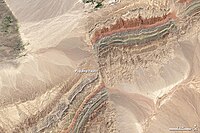
Photo from wikipedia
Abstract By applying conventional cross-track synthetic aperture radar interferometry (InSAR) and multiple aperture InSAR techniques to ALOS-2 data acquired before and after the 2014 Northern Nagano, central Japan, earthquake, a… Click to show full abstract
Abstract By applying conventional cross-track synthetic aperture radar interferometry (InSAR) and multiple aperture InSAR techniques to ALOS-2 data acquired before and after the 2014 Northern Nagano, central Japan, earthquake, a three-dimensional ground displacement field has been successfully mapped. Crustal deformation is concentrated in and around the northern part of the Kamishiro Fault, which is the northernmost section of the Itoigawa-Shizuoka tectonic line. The full picture of the displacement field shows contraction in the northwest–southeast direction, but northeastward movement along the fault strike direction is prevalent in the northeast portion of the fault, which suggests that a strike-slip component is a significant part of the activity of this fault, in addition to a reverse faulting. Clear displacement discontinuities are recognized in the southern part of the source region, which falls just on the previously known Kamishiro Fault trace. We inverted the SAR and GNSS data to construct a slip distribution model; the preferred model of distributed slip on a two-plane fault surface shows a combination of reverse and left-lateral fault motions on a bending east-dipping fault surface with a dip of 30° in the shallow part and 50° in the deeper part. The hypocenter falls just on the estimated deeper fault plane where a left-lateral slip is inferred, whereas in the shallow part, a reverse slip is predominant, which causes surface ruptures on the ground. The slip partitioning may be accounted for by shear stress resulting from a reverse fault slip with left-lateral component at depth, for which a left-lateral slip is suppressed in the shallow part where the reverse slip is inferred. The slip distribution model with a bending fault surface, instead of a single fault plane, produces moment tensor solution with a non-double couple component, which is consistent with the seismically estimated mechanism.
Journal Title: Tectonophysics
Year Published: 2017
Link to full text (if available)
Share on Social Media: Sign Up to like & get
recommendations!